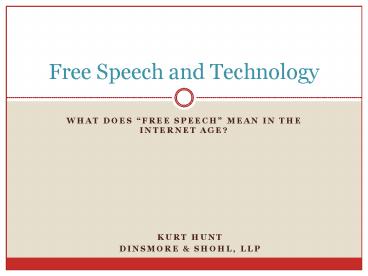What does free speech MEAN in the internet age - PowerPoint PPT Presentation
1 / 43
Title:
What does free speech MEAN in the internet age
Description:
Congress shall make no law respecting an establishment of religion, or ... New York Times v. Sullivan (1964) Defamation. Publication. False. About the Plaintiff ... – PowerPoint PPT presentation
Number of Views:34
Avg rating:3.0/5.0
Title: What does free speech MEAN in the internet age
1
Free Speech and Technology
- What does free speech MEAN in the internet age?
Kurt Hunt Dinsmore Shohl, LLP
2
The First Amendment
- Congress shall make no law respecting an
establishment of religion, or prohibiting the
free exercise thereof or abridging the freedom
of speech, or of the press or the right of the
people peaceably to assemble, and to petition the
government for a redress of grievances.
3
The First Amendment
- Congress shall make no law . . . abridging the
freedom of speech, or of the press.
4
The First Amendment
- Congress shall make no law . . . abridging the
freedom of speech, or of the press.
5
The First Amendment
- Congress shall make no law . . . abridging the
freedom of speech, or of the press.
6
The First Amendment
- A profound national commitment to the
principle that debate on public issues should be
uninhibited, robust, and wide-open, and that it
may well include vehement, caustic, and sometimes
unpleasantly sharp attacks on government and
public officials. - Supreme Court of the United States
- New York Times v. Sullivan (1964)
7
Defamation
- Publication
- False
- About the Plaintiff
- Harm to Reputation
- Either
- negligent failure to discovery truth or falsity
(private figure) - knowing falsity or reckless disregard for truth
(public figure)
8
Regulation of Speech
9
Traditional Structure
10
Traditional Structure
11
Traditional Structure
12
Structure of the Internet
13
Internet Structure
14
Traditional Structure
15
Traditional Intermediaries Are Bottlenecks
- "The First Amendment interest of the public in
being informed is said to be in peril because the
marketplace of ideas is today a monopoly
controlled by the owners of the market. - Supreme Court of the United States
- Miami Herald Publishing Co v. Tornillo (1974)
16
Traditional Structure
17
Internet Structure
18
Internet Structure
19
Regulating Online Speech
20
First Amendment Applies to Online Speech
- "'The content on the Internet is as diverse as
human thought.' . . . Our cases provide no
basis for qualifying the level of First Amendment
scrutiny that should be applied to this medium. - Supreme Court of the United States
- Reno v. ACLU (1997)
21
Anonymity
22
Anonymity
23
Anonymity
24
Internet Structure
25
Communications Decency Act
- No provider or user of an interactive computer
service shall be treated as the publisher or
speaker of any information provided by another
information content provider. - 47 U.S.C. 230
26
Internet Structure
27
YouTube Community Guidelines
- YouTube is not for pornography or sexually
explicit content. If this describes your video,
even if it's a video of yourself, don't post it
on YouTube. - Don't post videos showing bad stuff like animal
abuse, drug abuse, under-age drinking and
smoking, or bomb making. - Graphic or gratuitous violence is not allowed.
If your video shows someone being physically
hurt, attacked, or humiliated, don't post it. - YouTube is not a shock site. Don't post
gross-out videos of accidents, dead bodies or
similar things intended to shock or disgust.
28
YouTube Community Guidelines (Contd.)
- You may not like everything you see. Some of the
content here may offend youif you find that it
violates our Terms of Use, then click the button
that says "Flag" under the video you're watching
to submit it for review by YouTube staff.
29
YouTube Community Guidelines (Contd.)
- Most nudity is not allowed, particularly if it
is in a sexual context.
30
Regulating Speech inthe Public Schools
31
Traditional Speech in Public Schools
- Students do not shed their constitutional right
to freedom of speech or expression at the
schoolhouse gate. - Supreme Court of the United States
- Tinker v. Des Moines Independent Community
Schools (1969)
32
Traditional Speech in Public Schools
- BUT
33
Traditional Speech in Public Schools
- Speech can be regulated if it materially
disrupts classwork or involves substantial
disorder or invasion of the rights of others. - Supreme Court of the United States
- Tinker v. Des Moines Independent Community
Schools (1969)
34
Traditional Speech in Public Schools
- Schools can regulate speech that includes the
use of obscene, profane language or gestures. - Supreme Court of the United States
- Bethel School District No. 403 v. Fraser (1986)
35
Off-Campus Speech
- Regulation requires connection to the school.
- School-sponsored event
- Distribution in school
36
Online Speech in Public Schools
- If accessed in school, speech is distributed
in school. - This is the potential hook to regulate.
37
Online Speech in Public Schools
- Online speech is distributed anywhere it is
requested.
38
Online Speech in Public Schools
- J.S. ex rel H.S. v. Bethlehem Area School
District (Pa. 2002) - Speech that is aimed at a specific school
and/or its personnel may be considered to be
brought onto the school campus or accessed at
school by its originator.
39
Online Speech in Public Schools
- Doninger v. Niehoff
- (2d Cir. 2008)
- School could regulate speech because the blog
posting directly pertained to events at the
school.
40
Online Speech in Public Schools
- Layshock vs. Hermitage School District
- (W.D. Pa. 2007)
- the mere fact that the Internet may be
accessed at school does not authorize school
officials to become censors of the World Wide
Web. Public schools are vital institutions, but
their reach is not unlimited.
41
Traditional Structure
42
Internet Structure
43
Contact Information
- Kurt R. Hunt
- Dinsmore Shohl, LLP
- kurt.hunt_at_dinslaw.com































